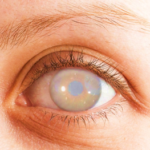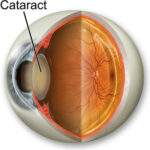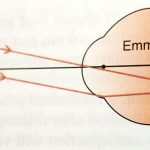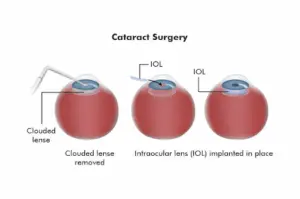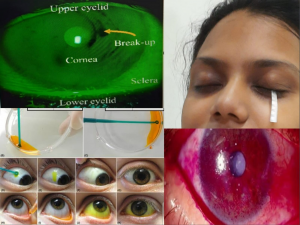Near-sightedness also known as short sightedness and Myopia is a refractive error or eye disorder where light rays focus in front of, instead of on the retina. Myopia is the most common type eye disorder and is estimated to affect 1.5 billion people. Both hereditary and environmental factors are essential for the growth of the Ocular tissues responsible for determining the refractive factor of the eye. Uncorrected Myopia is one of the most common causes of vision impairment globally along with Cataracts, Macular Degeneration and Vitamin-A deficiency .Myopia has been variously designated Simple, Physiologic, Pathologic, Progressive, Malignant, Degenerative, Congenital and acquired.
Myopia is classified in a simple manners as and it’s of four types:-
1) Congenital Myopia
2) Simple or Developmental Myopia
3) Pathological Myopia
4) Acquired Myopia
1) Congenital Myopia:-
A) Aetiology :- Congenital Myopia is generally amalgamated with an increase in axial length and overall globe size. It is seen in children who were born prematurely or with several birth defects , such as Homocystinuria and Marfan’s syndrome.
B) Clinical Features :-
a) Present since birth:- Congenital Myopia is commonly diagnosed by the age of 2-3 years. The child is born with expanded eyes.
b) High degree of error:- The refractive error may be up to -10D.Generally the error is of about 8-10D,which mostly remains constant.
c) Clinical fundus changes are seen.
d) Progression is rare.
e) Anisometropia:- The error is unilateral and manifest as Anisometropia most of the time. Rarely it may be bilateral
f) Associations:-. Congenital myopia may be attached with Congenital convergent squint and other Congenital disorder such as Cataract, Microphthalmos, Aniridia, Megalocornea and Congenital separation of cornea.
C) Diagnosis:- Unilateral Congenital Myopia is frequently discovered either by routine screening eye examination or after a strabismus develops because of the associated amblyopia. If the Myopia is bilateral, the child will usually display some noticeable difficulty in seeing distant objects and will hold things very close for viewing.
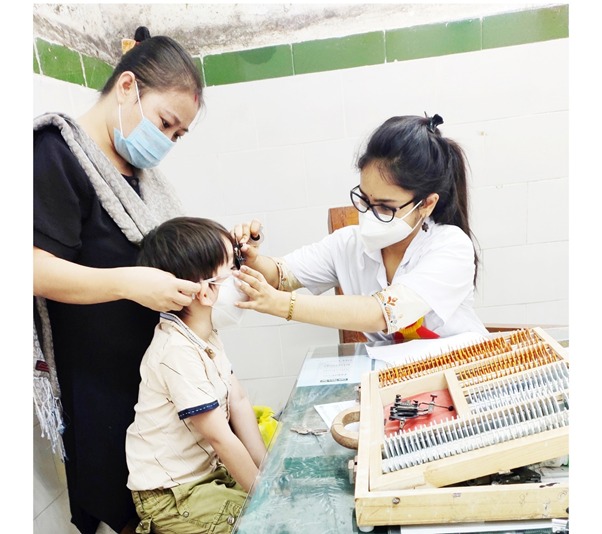
D) Treatment:- Early diagnosis and correction of Congenital Myopia is coverable to help the child to expand normal distant vision and perception of the World. The full Cycloplegic refractive error including any astigmatic correction should be prescribed. Even then it may not always be possible for these children to acquire 6/6 visual acuity in either eye.
E) Prognosis:- The prognosis for good vision and normal binocularity is poor in unilateral cases, if the myopia is acute.
2) Simple Myopia:-
Developmental Myopia-commonest variety School Myopia (School going age 8-12 years) Simple or Developmental Myopia also known as Physiological Myopia, is the Commonest variety. It is deliberated as a Physiological error not associated with any eye problems. Generally the onset occurrence at school going age between 8 and 12 years of age, so it’s also called School Myopia. About 29% of general population have low myopia (≤2D) and about 7% have moderate myopia (2-6D).
A)Etiology:-
some factors associated with Simple Myopia are as follows:-
a)Axial type of Simple Myopia may signify just a Physiological variation in the length of the eyeball or it may be associated with impertinent neurological growth during childhood.
b) Curvatural type of Simple Myopia is considered to be due to underdevelopment of the eyeball
c) Roll of Genetics :- Genetics plays an important role in the biological variation of the development of eye, as appearance of myopia is more in children with the both parent myopic (20%) than the children with one parent myopic (10%) and children with no parent myopic (5%). Inheritance is considered to be autosomal dominant.
d) Role of diet :-In early childhood has also been reported, without any decisive results.
e) Theory of excessive near work in childhood is being important, It’s believed that myopia is aggravated by close work, watching television, smart phones, Computer and by not using spectacles.
B) Clinical Features:-
Simple Myopia is nearly present since birth. Most of the patients are rather both Hypermetropic, but during advancement the normal mark is overshooted and the child becomes myopic. Simple myopia generally begins between 7 and 10 years of the age and may develop during the years of growth usually at about -5D or less and it never exceeds -8D. There is no useful method for halting the growth of this school Myopia once it has started.
C) Symptoms:-
1)Poor vision for distance is the main Symptom of myopia.
2)Half shutting of the eyes may be complained by the parents of the child.
3) Asthenopic Symptom occur in patient with small degree of Myopia. Exophoria or divergent squint.
4)Eye Strain.
D)Signs:-
1) Predominant eyeballs. Myopic eyes are large and prominent.
2) Pupils are large.
3) Anterior Chamber is slightly deeper than normal.
4)Fundus is normal. No degenerative changes are seen.
E)Diagnosis:- It is confirmed by performing retinopathy.
3)Pathological Myopia:-
Terminologies of Pathological Myopia:-
1)Degenerative Myopia
2)Malignant Myopia
3)High degree Myopia
4)Progressive Myopia
5)Magna Myopia
Pathological myopia, as the name indicates is a rapidly progressive error which starts in childhood at 5-10 years of age and results in high Myopia (7-6)D during early adult life which is generally associated with degenerative changes in the eye.
- Etiology:-
It is obvious that the Pathological myopia results from a rapid axial growth of the eyeball which is outside the normal biological variations of the development. It is definitely joined with, heredity and general growth.
a)Role of heredity:- It is now substantiated that genetic factors play an important role in the aetiology as the progressive myopia is familial, more general in certain races like Japanese, Chinese, Arabians. At present high Myopia (>6D) is considered to be a sex-linked, recessive inherited disease. It is presumed that heredity-linked growth of retina is the determinant in the progression of myopia. The increased axial length, degenerative changes in retina and choroid, vitreous changes and pathological Complications are determined by various genes.
b)Though the Role of general growth process minor, can’t be denied in the progress of myopia. Lengthening of the posterior segment of the globe commences only during the period of active growth and probably ends with the termination of the active growth. Therefore the factors (such as Nutritional deficiencies, Debilitating diseases, Endocrinal disturbances and indifferent general health). With affect the general growth process may also have some influence of the progression of MYOPIA
B) Symptoms:-
1)Defective vision, uncorrectable loss of vision may occur due to Progressive degenerative changes.
2)Muscae volitantes and floating black opacities in front of the eyes are also complained by most of the patient. It occurs due to degenerated liquefied vitreous.
3)Night blindness may be complained by many high myopic patients.
C)Signs:-
1) Predominant eyeballs
2)Cornea is large
3)Anterior Chamber is deep
4) Pupils are slightly large
5)Optic disc appears large and pale
6) Degenerative changes in retina choroid are common in Progressive Myopia. Retinal tear, Haemorrhage and even Retinal detachment may be seen as complications of Myopic chorioretinal degeneration. Cystoid degeneration maybe seen at the periphery. It is important that these Degenerative changes in the fundus are not necessarily comparable with the degree of myopia, for they may be more marked when the Myopia is slight and less marked when the error is very .
7) Posterior staphyloma due to ectasia of sclera at the posterior pole maybe apparent as an excavation, with the vessels bending backward over its margins.
8)Visual fields show contraction and in some cases ring scotoma may be seen.
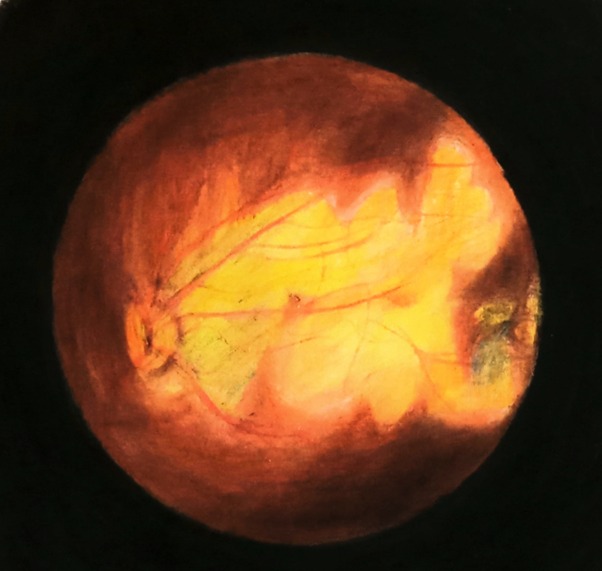
Fig 2 : Fundus changes in Pathological Myopia
D)Complications:-
1)Retinal detachment and retinal tear are seen.
2) Complicated cataract, vitreous haemorrhage, choroidal haemorrhage, nuclear sclerosis may occur.
3)POAG is not a complication but a common association of Pathological Myopia.
4) Acquired Myopia:-
Some of causes of Acquired myopia are as follows:-
a)Curvatural Myopia:- It may be corneal or lenticular. Corneal Curvatural Myopia develops in many cases of increase of corneal curvature in some conditions such as keratoconus. Lenticular Curvatural Myopia may also occur due to increase of lenticular curvature in some conditions such as Lenticonus anterior and posterior.
b)Positional Myopia:- It may develops in some conditions such as anterior subluxation of the lens.
c)Index Myopia:- Diabetic Myopia occurs due to decrease in the refractive index of cortex. Incipient cataract may also generate index myopia. Nuclear Sclerosis may also develop more and more hyper-refringentpari passu,which occurs a progressive myopia.
d)Consecutive Myopia:- It may occur due to surgical overcorrection of Hypermetropia and pseudophakia with overcorrecting IOL.
e)Pseudomyopia:- It also occurs some conditions such as excessive accommodation and spasm of accommodation. It’s also increases after full hypermetropic correction in children.
G)Night Myopia:- The shift from photopic to scotopic vision twilight is associated with developed sensitivity to the shorter wavelengths of light. If accommodation for the middle range of the visual spectrum will be slightly myopic for the shorter wavelengths.
H)Space Myopia:- When the individual has no stimulation for distance fixation, the eyes suppose to choose a near fixation plane which can be very variable. This condition the degree of myopia is never more than 0.75-1.5D.
I)Drug-induced Myopia:- It occurs Cholinergic drugs such as Pilocarpine, Echothiophate Steroid-induced Myopia may happen because of water metabolism changes involving the lens. Sulphonamides may also reveal myopia for the slight changes in the refractive indices of the media.

